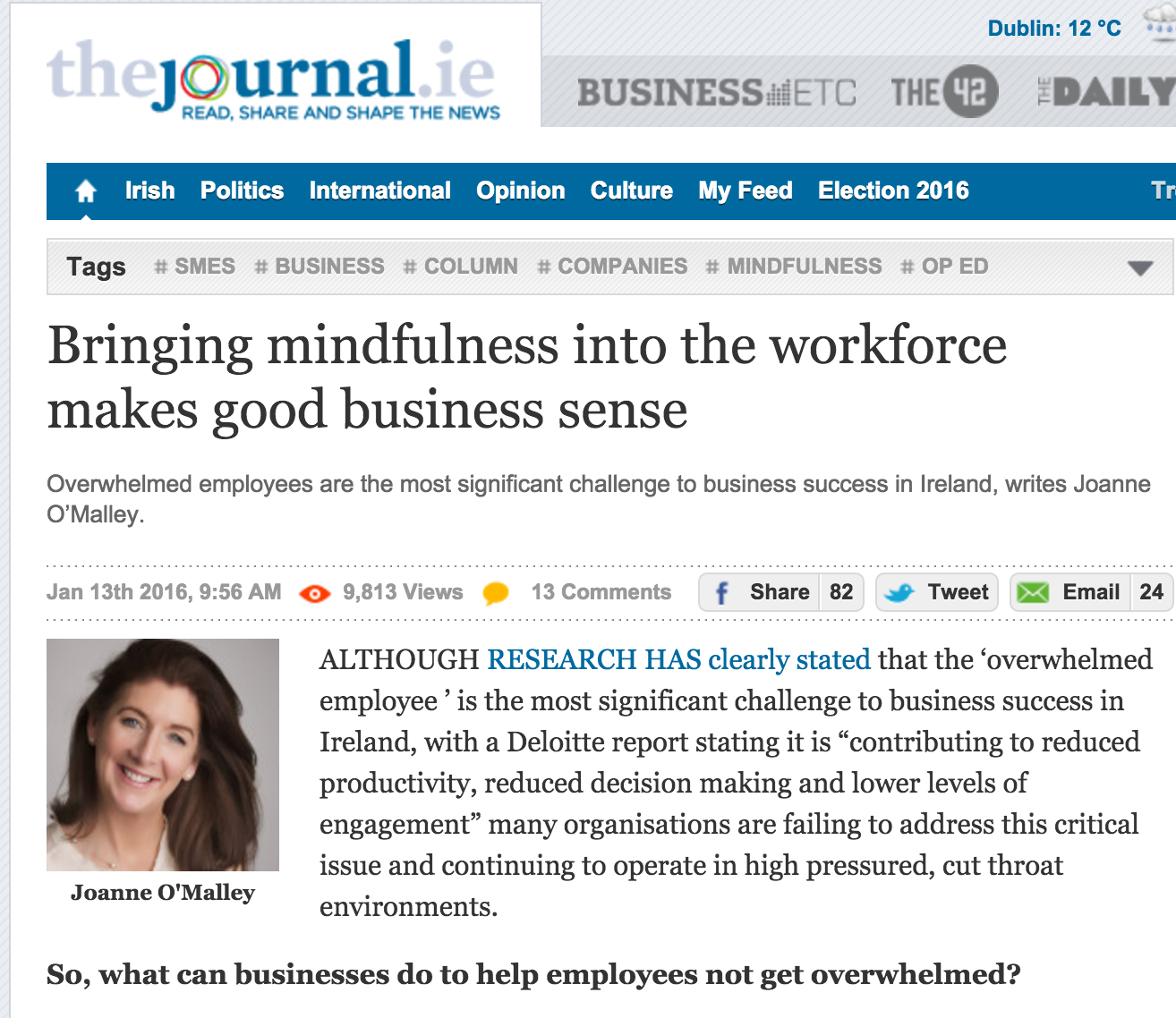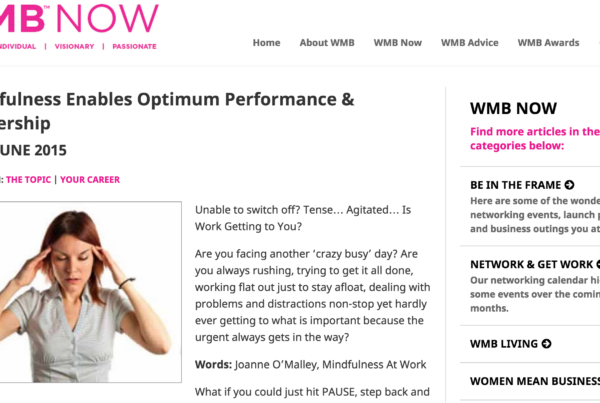Overwhelmed employees are the most significant challenge to business success in Ireland.
ALTHOUGH RESEARCH HAS clearly stated that the ‘overwhelmed employee ’ is the most significant challenge to business success in Ireland, with a Deloitte report stating it is “contributing to reduced productivity, reduced decision making and lower levels of engagement” many organisations are failing to address this critical issue and continuing to operate in high pressured, cut throat environments.

What’s the evidence show about high pressure workplaces?
Mounting evidence shows that a harsh workplace is bad for sustained productivity and in fact a positive environment correlates with employee and business wellbeing. This contradicts the long held belief that stress and pressure push employees to perform best.
Does a stressful environment cost the business?
Harvard Business Review’s recent article: ‘Proof that positive cultures are more productive’ outlined the hidden costs. In summary:
- Healthcare costs are spiralling and 50% higher in high pressure companies
- Disengaged employees have 18% less productivity, 16% lower profitability, 37% lower job growth, 65% lower share price, 49% more accidents, 60% more errors
- Workplace stress leads to an increase of almost 50% in voluntary turnover; significant given that replacing a single employee costs about 20% of salary.
How does ‘overwhelm’ occur?
Over a decade ago, Harvard Business Review published a paper: Overloaded Circuits : Why Smart People Underperform that explains clearly why this critical issue occurs.
Caused by brain overload, attention deficit trait (ADT) is now epidemic in organisations and springs entirely from the environment. The core symptoms are distractibility, inner frenzy, and impatience.
People have difficulty staying organised, setting priorities, and managing time. The brain gradually loses its capacity to attend fully to anything, becoming increasingly hurried, curt, unfocused, while pretending that everything is fine.
What happens in the brain of an overwhelmed employee?
When the frontal lobes that are in charge of executive functioning, like – decision making/planning /prioritisation and other sophisticated tasks have ‘too much to do’, the threat system unconsciously triggers the primitive ‘survival’ part of the brain which then assumes control.
Not just the brain, but the whole body shifts into crisis mode and the physiology moves from peace to red alert. So, in a futile attempt to work faster, to do more with less, the brain paradoxically reduces its ability to function clearly, the perceptual field narrows and intelligence dims.
Overwhelmed employees can make impulsive decisions, rash judgments, are unsafe, prone to accidents, get into conflict, lack self control.

Here’s why… Bringing Mindfulness into the workforce makes good business sense
Mindfulness is a way of paying attention. Training usually starts by just following the breath. Breathing mindfully triggers the vagus nerve (the commander-in-chief when it comes to having grace under pressure) , stimulating the parasympathetic nervous system which immediately calms the body and mind, lowering stress, reducing heart rate and blood pressure.
In addition, when you purposely move attention to the felt sense of the breath, you break free of ‘the story in the head’ and become fully present, temporarily free of anxiety and regret. This ‘pause’ is an opportunity for mental and emotional rest, to reset and the secret to sustaining high performance for extended periods.
The more you practice and build the muscle, the more you strengthen the parts of your brain involved with attention and executive control, principally the prefrontal cortex.
Science shows that Mindfulness helps keep our mind healthy…
The Harvard Business Review: Mindfulness can literally change your brain states:
Neuroscientists have shown that practicing mindfulness affects brain areas related to perception, body awareness, pain tolerance, emotion regulation, introspection, complex thinking, and sense of self. The converging evidence is compelling and mindfulness should no longer be considered a “nice-to-have” for executives. It’s a “must-have”: a way to keep our brains healthy, to support self-regulation and effective decision-making capabilities, and to protect ourselves from toxic stress.
Everyone knows that training makes our bodies stronger, fitter and more flexible. Now, neuroscience research shows that mindfulness training cultivates the innate capacities of the brain to be present, to step out of automatic pilot and to create space so we can be clearer, calmer, more focused, more creative, even more compassionate.
Bringing Mindfulness into the workforce makes good business sense
Based on published studies, mindfulness appears to be effective in reducing levels of stress and increasing levels of resilience and emotional intelligence. It raises the level of self-awareness and awareness of others; it increases interpersonal sensitivity and communication skills.
It lowers rates of health-related absenteeism, leads to increased concentration and extends one’s attention span. It reduces impulsivity and improves one’s capacity to hold and manipulate information. It lowers levels of psychological distress and raises levels of well-being and overall work and life satisfaction.

Aetna’s case study delivers astonishingly positive results
An example of how it worked in one company, is with healthcare company, Aetna.
It’s CEO Mark Bertolini is an example of how one leader has reshaped the culture and transformed a stodgy insurance company into one of the most progressive actors in corporate America.
Aetna’s stock has increased threefold since Bertolini took over as chief executive in 2010, and recently hit a record high.
Due to his personal experience with yoga and meditation following a major skiing accident, he launched a 10 week mindfulness training programme in which more that 12,000 of Aetna’s 50,000 employees have now participated.
Results show 28% less stress, 20% improved sleep, 19% less pain as well as lower heart rate and lower cortisol levels.
This equates to a saving of $2,000 in healthcare costs and a gain of $3,000 in productivity so a total of $5,000 per employee which Aetna believe underestimates the full financial value of mindfulness training, as it doesn’t include the positive recuppercions on sales, turnover, rehiring, retraining costs or customer service.
Bringing Mindfulness into the workforce makes good business sense
It’s a no brainer. The business case for mindfulness at work is clear beyond doubt.
In today’s workplace, employees who are able to intentionally create a quality of mind that is calm, clear and focused; employees that can clearly see when and how they are triggered and deploy practical skills to manage themselves better, navigate challenges, be present, stay creative, communicate clearly, maintain awareness of themselves, others and the environment are at a significant advantage in terms of the value they bring the business.
Not to mention, the gains they create across the organisation in terms of health, wellbeing, relationships and culture.
This article was written by Joanne O’Malley of Mindfulness at Work





